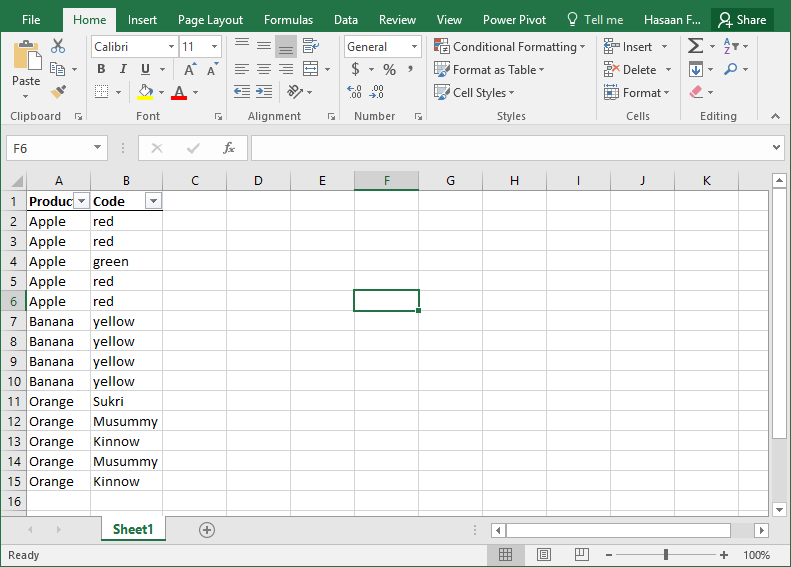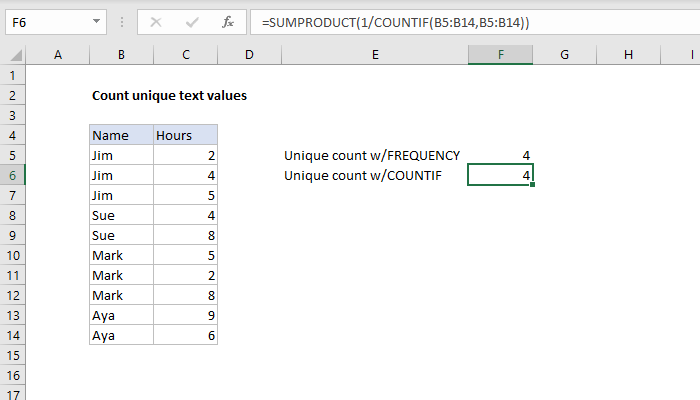Excel Count Distinct Values In Column
Excel Count Distinct Values In Column - To list the unique values in the cell range A2 through A5 you would use this formula UNIQUE A2 A5 You can see here we have three distinct values listed To count those unique values instead of listing them you add the COUNTA function to the beginning of the formula COUNTA UNIQUE A2 A5 Count the number of unique values by using a filter Count the number of unique values by using functions Examples Function details Need more help You can always ask an expert in the Excel Tech Community or get support in Communities See Also Filter for unique values or remove duplicate values Need more help Want more options Discover Community You can also refer to a list of unique values already extracted to the worksheet with the UNIQUE function using a special kind of cell reference The formula in D5 is UNIQUE B5 B16 which returns the seven values seen in D5 D11 To count these values with a dynamic reference you can use a formula like this COUNTA D5
In case that you are looking for a easy and efficient way to improve your productivity, look no further than printable templates. These time-saving tools are simple and free to use, offering a variety of benefits that can help you get more performed in less time.
Excel Count Distinct Values In Column

Count Distinct Values In Excel With Multiple Criteria strings Stack
 Count Distinct Values In Excel With Multiple Criteria strings Stack
Count Distinct Values In Excel With Multiple Criteria strings Stack
Excel Count Distinct Values In Column Printable design templates can help you remain organized. By providing a clear structure for your tasks, order of business, and schedules, printable design templates make it simpler to keep everything in order. You'll never need to stress over missing out on due dates or forgetting important tasks again. Utilizing printable design templates can assist you conserve time. By getting rid of the need to create brand-new files from scratch every time you need to finish a job or plan an event, you can concentrate on the work itself, rather than the paperwork. Plus, lots of templates are personalized, allowing you to customize them to match your requirements. In addition to conserving time and staying arranged, using printable templates can likewise help you remain motivated. Seeing your development on paper can be an effective incentive, motivating you to keep working towards your goals even when things get difficult. Overall, printable design templates are a terrific method to improve your performance without breaking the bank. So why not give them a shot today and begin achieving more in less time?
Countif Unique Values Excel With Multiple Criteria Uniqe Ideas
 Countif unique values excel with multiple criteria uniqe ideas
Countif unique values excel with multiple criteria uniqe ideas
The solution is to use the SUM function in combination with IF and COUNTIF SUM IF COUNTIF range range 1 1 0 Note This is an array formula so be sure to press Ctrl Shift Enter to complete it Once you do this Excel will automatically enclose the formula in curly braces like in the screenshot below
The tutorial looks at how to leverage the new dynamic array functions to count unique values in Excel formula to count unique entries in a column with multiple criteria ignoring blanks and more A couple of years ago we discussed various ways to count unique and distinct values in Excel
Count Distinct Values In Excel With Multiple Criteria strings Stack
 Count distinct values in excel with multiple criteria strings stack
Count distinct values in excel with multiple criteria strings stack
Excel Count Distinct Values In The Entire Sheets Stack Overflow
 Excel count distinct values in the entire sheets stack overflow
Excel count distinct values in the entire sheets stack overflow
Free printable templates can be an effective tool for improving performance and accomplishing your objectives. By selecting the ideal templates, incorporating them into your routine, and individualizing them as required, you can streamline your daily tasks and take advantage of your time. So why not give it a try and see how it works for you?
The syntax for this combined formula is SUM IF 1 COUNTIF data data 1 1 0 Here the COUNTIF formula counts the number of times each value in the range appears The resulting array looks like 1 2 1 1 1 1 In the next step you divide 1 by the resulting values
To count the number of unique values in a range of cells you can use a formula based on the COUNTIF and SUMPRODUCT functions In the example shown the formula in F6 is SUMPRODUCT 1 COUNTIF B5 B14 B5 B14 In Dynamic Excel you can use a simpler and faster formula based on UNIQUE Generic formula SUMPRODUCT 1 COUNTIF data data